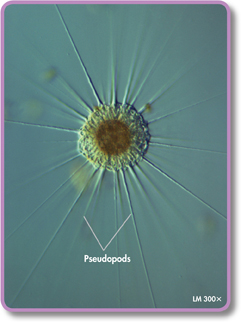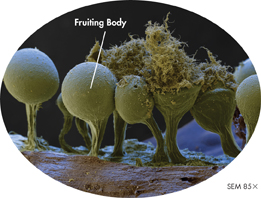Rhodophytes 
Also known as the red algae, these organisms get their name (from Greek, rhodo = red and phyte = plant) from reddish accessory pigments called phycobilins (fy koh BIL inz). These highly efficient pigments enable red algae to grow anywhere from the ocean's surface to depths as great as 268 meters. Most species are multicellular. Rhodophytes are the sister group to kingdom Plantae.

Some things that we call seaweeds, such as this rhodophyte, are actually protists. (LM 35X)
Amoebozoa 
Members of the Amoebozoa (uh MEE boh zoh ah) are amoebalike organisms that move by means of cytoplasmic streaming, also called amoeboid movement, using pseudopods.

This solitary amoeba, Penardia mutabilis, has very slender pseudopods.

Slime molds live as single microscopic amoebas in the soil, but aggregate into a colony when conditions are right, forming a multicellular fruiting body. In this image, some of the fruiting bodies have burst, releasing spores.
Choanozoa 
Members of the clade Choanozoa (koh AN uh zoh uh) can be solitary or colonial and are found in aquatic environments around the world. This clade is the sister group to kingdom Animalia.
Choanoflagellates are a major group in the clade Choanozoa. They get their name from a collar of cytoplasm that surrounds their single flagellum (form Greek, choano = collar.) Many species trap food within the collar and ingest it.
Table of Contents
- Formulas and Equations
- Applying Formulas and Equations
- Mean, Median, and Mode
- Estimation
- Using Measurements in Calculations
- Effects of Measurement Errors
- Accuracy
- Precision
- Comparing Accuracy and Precision
- Significant Figures
- Calculating With Significant Figures
- Scientific Notation
- Calculating With Scientific Notation
- Dimensional Analysis
- Applying Dimensional Analysis




